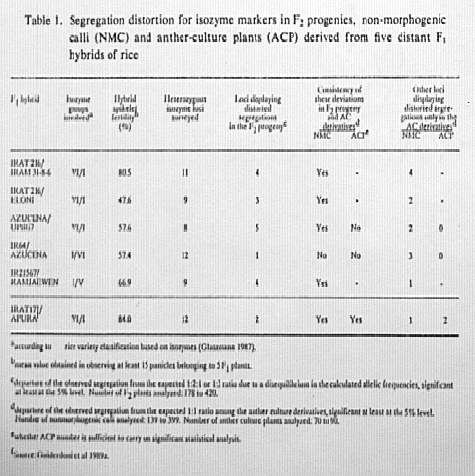Plant Breeding Department, International Rice Research Institute, P.O. Box 933, Manila, Philippines. Present address: IRAT/CIRAD, BP 5035, 34032 Montpellier Cedex, France
Aside from field evaluation, an accurate means to test the existence of gametic selection occurring during the androgenetic pathway is the comparative study of segregations of genetic markers among both sexual (F2 or backcrossed plants) and anther culture derivatives. In cultivated rice (Oryza sativa L.), the isozyme loci appear to be suitable markers for this purpose because of their high level of polymorphism in distantly related varieties (Glaszmann 1987) and their wide expression in anther culture derivatives (Guiderdoni et al. 1988, 1989a).
In this study, segregations for 8 to 12 heterozygous isozyme markers were surveyed among F2 progenies and anther culture derivatives (i.e., nonmorphogenic microspore-derived calli (NMC) and anther culture-derived plants (ACPs)) of five distant F1 hybrids between-varieties belonging to the isozyme groups I (indica), V ("Basmati group"), and VI (Japonica) (Glaszmann 1987; Table 1). Significant departures from the expected ratios were found at 1 to 5 loci among the F2 derivatives, indicating that in vivo gametic selection, which is most probably related to intergroup F1 hybrid sterility, took place during gametogenesis. The alleles overrepresented in the F2s were generally found in excess in the NMC populations which, on the other hand, displayed further distortions at 1 to 4 loci depending on the hybrid used. This result suggests that the nonmorphogenic calli derive from a microspore pool that sustains both gametogenetic and androgenetic gametic selections. However, neither the Indica nor the Japonica allelic type was favored at all the distorted loci by one or the other gametic selection.
As to the ACP populations, the segregations fitted the expected 1 : 1 ratio at all loci surveyed in IR64/Azucena (one of 12 loci showed distorted segregation in the F2s) and in Azucena/UP1Ri7 (5 of 8 markers displayed distorted segregations in the F2s). the morphogenic pathway of androgenesis seems therefore to avoid in vivo pollen selection occuring during subsequent stages of the microsporo-
Table 1. Segregation distortion for isozyme markers in F2 progenies, non-morphogenic calli (NMC) and anther-culture plants (ACP) derived from five distant F1 hybrids of rice

genesis, and in vitro gametic selection which both affect segregations in NMC
populations. In Azucena/UP1Ri7, anther culture bypasses a phenomenon that
appears related to F1 distant-hybrid sterility which is known to hinder the
conventional exploitation of rice remote crosses.
As this result contrasts with the consistent segregation distortions observed in microspore derived-calli and doubled haploid lines derived from the Japonica/ Indica hybrid Irat177/Apura (Guiderdoni et al. 1989a,b), our study must be broadened to include other ACP populations to enable us to come up with generalizations. However, this apparent discrepancy could be tentatively explained by the existence, aside from the effect of F1 distant hybrid sterility, of another segregation distorting mechanism in our hybrid materials since segregation distortion of isozyme markers has been recently noticed in the F2s of several intra-japonica crosses (M. Arraudeau, personal communication). These mechanisms might interfere with gametogenesis at different levels and stages and consequently may or may not affect the morphogenetic pathway of androgenesis.
References
Glaszmann, J. C., 1987. Isozymes and classification of Asian rice varieties. Theor. Appl. Genet. 74: 21-30.
Guiderdoni, E., B. Delos Reyes and G. Vergara, 1988. Expression and segregation of isozyme genes in rice microspore derived calli. Int. Rice Res. Newsl. 13: 10-11.
____, B. Courtois and J. C. Glaszmann, 1989a. Use of isozyme markers to monitor recombinations and assess gametic selection among anther culture derivatives of remote crosses of rice. 2nd International Symposium on Genetic Manipulation in Crops. CIMMYT, El Batan, Mexico. Aug. 29-31, 1988. (in press).
J. C. Glaszmann and B. Courtois, 1989b. Segregation of 12 isozyme genes among doubled haploid lines derived from a japonica/indica cross of rice. Euphytica. (in press).